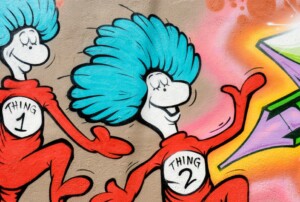
I’m writing a book.
I’m writing a screenplay.
I’m giving a presentation such as a TED Talk.
When you think about what a story is, those probably come to mind immediately.
The truth is, the art of storytelling goes much deeper and is applied to just about everything in our lives.
Today, as entrepreneurs trying to truly make a positive difference in the world, the art of storytelling is more important than ever if you want to connect to your audience.
But first, it helps to understand that our brains have been hardwired for storytelling. It’s how to take a lot of data picked up from our senses and start making sense out of it so we don’t go crazy.
I’m a storyteller. You’re a storyteller. We are all storytellers.
We can all also say that we know how to draw, it’s innate. Give a child a pencil and through instinct, they will create a stick figure. Not the prettiest drawing but a drawing nonetheless. However, to reach a level of excellence, we must learn about the depths of any subject and practice…a lot. Maybe you’ve heard about the book by Malcolm Gladwell, Outliers? He found that someone must learn and practice for 10,000 hours give or take a few to become an expert.
Why Your Business Marketing Might Not Be Working
As founders, we have to figure out how to get traction which means find our audience and getting them interested in what we are doing. How to connect with them.
Not always an easy task.
There are many variables that impact marketing results.
But let’s get to the root of it and talk about some BIG barriers and trends you must be aware of to learn how to connect with your audience.
1 – Know What You’re Up Against
Over the years people have faced all kinds of marketing tactics. Everything from false claims, to interruptions, popups and completely irrelevant display banners that are shoved in front of them.
This has conditioned people to hate advertising on many levels which means their guards are up. They don’t want to be interrupted or fooled.
Here are some examples of what I’m talking about…
2 – Interruption Marketing
How many times in your life has a commercial or ad showed up in the middle of something like a TV show or video, and you say to yourself, “dammit, I hate ads!”
Maybe you were on a website and some popup shows itself and looks like malware virus that is spam? Yup, that led to more people saying, “I hate advertising.”
That is what we call interruption marketing.
In 2016 the global number of people using ad blocker software jumped to jumped to 615M! Adobe showed that $41B in ads would be blocked in 2016. The fact that people are growing more concerned about viruses and security will only continue ad blocking to grow.
3 – Display Ads
What about those classic display ads?
Well, simply put, people have learned to ignore them.
A study done by Infolinks found that “after being asked to recall the last display ad they saw, only 14% of users could name the company, the brand or the product. This suggests that brands are wasting millions of dollars in ads that consumers don’t remember or even notice.
Related: Download 18 Marketing Secrets From 100+ Expert Interviews!
Why Storytelling IS Marketing More Than Ever Today
As the internet has become more saturated over the years brands continue to find ways to jam advertisements in front of us. We are hit from all angles and after years of fake bullshit ads we not only learned to reject them as skeptics but we have started to crave a human touch with real authenticity.
You know you ‘have to’ spread the word about your business in order to have a big impact and generate great revenues… but it feels difficult, overwhelming, salezy, and unethical even?
When you put your story at the heart of your marketing effort, this authenticity bridges the gap between you and your audience. You can say less and have a much bigger impact – once you master the art of storytelling.
Once you find the right words and the best way to share your story you will attract your ideal audience. It will resonate with them on a deeper level so they are attracted in a real way that earns their trust.
“If what you’re doing matters, really matters, then I hope you’ll take the time to tell a story. A story that resonates and a story that can become true.” ~Seth Godin
3 – A Look at The Magic Behind The Art of Storytelling
Storytelling is not just an art, it’s a science.
Good stories literally change the chemistry of our brains. So, before you practice you must understand what makes it work.
Humans are emotional creatures and as you probably already know we have the ability to empathize with others. Empathy is important for social creatures because it allows us to understand how others are likely to react to a situation.
When you wrap your story in meaning and shift in values you can erase the skepticism we discussed earlier and start earning trust.
There are many types of stories entrepreneurs can tell – founder/origin, company, product, consumer…etc.
All great stories are the same. What that means is they flow according to a structure defined as an arc. It’s known as the dramatic arc.
The dramatic arc according to Gustav Freytag includes six key parts that empower stories for the most impact:
- Exposition (inciting incident): The exposition is like the set-up of the story. The background information that is needed to understand the story is provided, such as the main character, the setting, the basic conflict, and so forth.
- The exposition ends with the inciting moment, which is the one incident in the story without which there would be no story. The inciting moment sets the rest of the story in motion.
- Rising Action: Rising action is a series of events and actions that move to story to a climax. During rising action, the basic conflict is complicated by secondary conflicts, such as obstacles and challenges that frustrate the main character’s attempt to reach their goal.
- Climax (turning point): The climax is the peak of the action and the turning point in the story. After the climax, everything changes. Things will have gone badly for the main character up to this point; now, things will begin to go well for him or her. However, if the story is a tragedy, the opposite will happen after the climax; things that have been going well for the main character begin to go bad.
- Falling Action: During the falling action, the conflict unravels with the main character either winning or losing. The falling action might contain a moment of final suspense, during which the final outcome of the conflict is in doubt.
- Resolution: The story ends with the resolution, in which the main character is better off than at the beginning of the story. However, the tragedy ends with death and sadness, in which the protagonist is worse off than at the beginning of the story.
When we interviewed social entrepreneur and founder of Brave Soles, Christal Earle, she told us something interesting:
“…and one of the things I’ve come to realize, and the feedback that we get now, when people buy our stuff, and when they talk about us online is they always say, like, “I love that I know the story behind what I’m wearing”. […] People want to be connected to what they own, they want to have a sense of pride in those choices.” ~ Christal Earle
This is common for impact brands and social entrepreneurs. People today are demanding morals be put back into business and they want to connect with your mission and origin story.
The story is what people remember and talk about. They buy the experience and story, not just a product.
4 – The Experiment
Paul J. Zak pioneered research in the field of neuroeconomics (a field that seeks to explain human decision making, the ability to process multiple alternatives and to follow a course of action) and works on storytelling with the Department of Defense to help them understand why stories are so persuasive.
In this video, they share some of the fascinating experiments they did to learn about the science of storytelling.
5 – Final Words & Next Steps
I have personally interviewed over 100+ impact entrepreneur experts and when it comes to marketing something has always stood out – The importance of understanding human psychology and how people work.
It’s a lifelong learning process that you continue to figure out and learn how to become excellent.
While one article cannot teach you how to be a master storyteller, I hope that it has opened your eyes to the trends of marketing and the potential behind the art of storytelling to connect with your audience today.
Change Creator is here to empower socially-conscious founders like you to take your passion and successfully make a difference. Because the world needs you.
We believe that storytelling is one of the most important skills to master today in order connect with your audience and scale your impact.
This is why we partnered up with other impact entrepreneurs and experts to create, Captivate. A program designed to put your story at the heart of your marketing.
Now, you have the can of paint but you must learn how to create your masterpiece.
Related: Download 18 Marketing Secrets From 100+ Expert Interviews!
You might also love:
Seth Godin on Leadership for the 21st Century
Jay Shetty: What is Storytelling and What Makes a Good Story?






